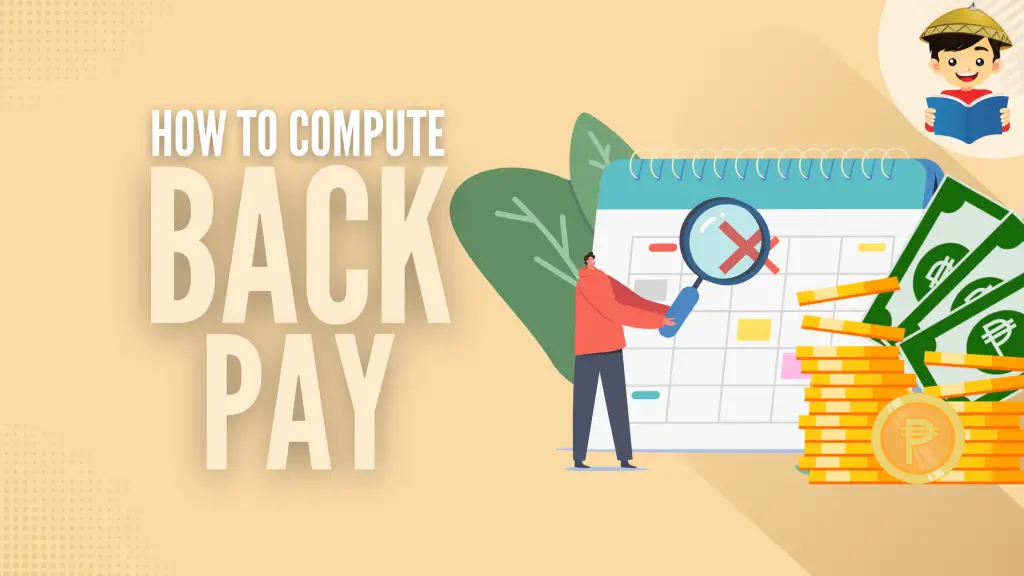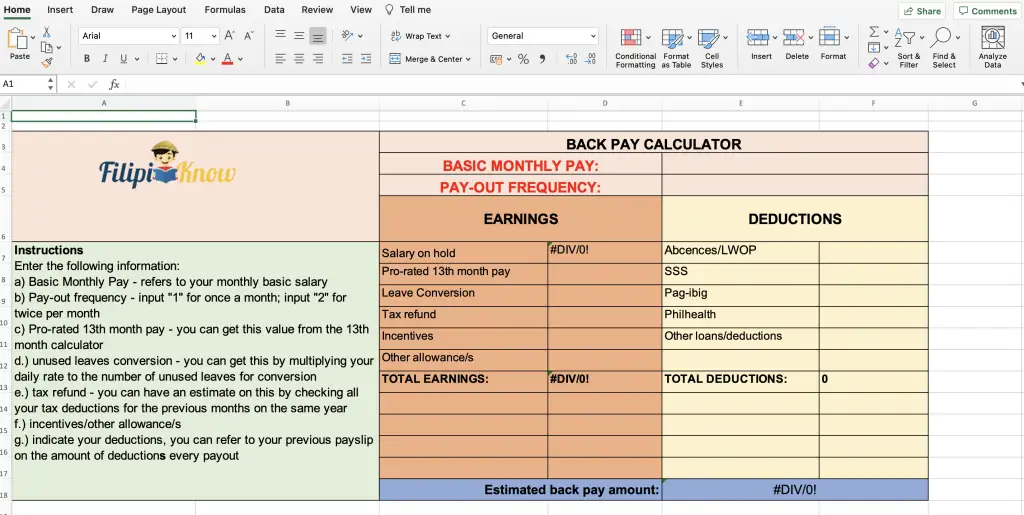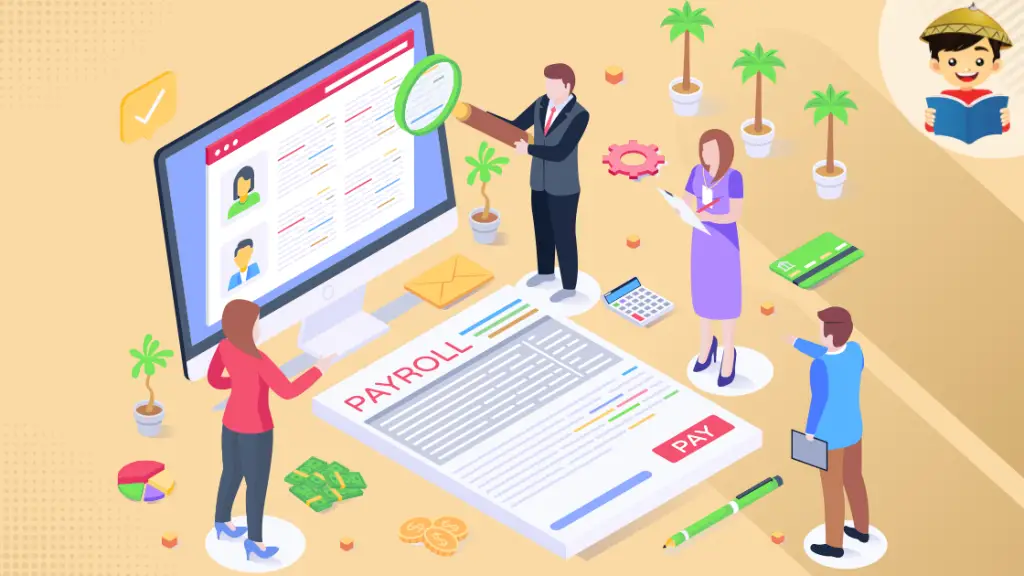How To Compute Back Pay in the Philippines (With FREE Calculator)

An employee moves from one employer to another due to multiple reasons. It could be because a particular work arrangement that fits the needs of several employees may not be convenient to him. Perhaps it’s the desire to explore better, higher-paying opportunities. One may also leave a job due to personal or family issues.
Regardless of the reason for the end of employment, knowing how to compute back pay is necessary so you can plan your finances while waiting for your subsequent employment.
This article provides the nitty-gritty of back pay computation.
Table of Contents
Free Download: Back Pay Calculator in Excel

No time to do manual computations? No problem! We’ve created a back pay calculator in Excel format, so you won’t have to. It includes instructions on using it and what information you must enter to estimate how much back pay you’ll get.
Ready to get started? Click here to download our free back pay calculator in Excel.
What Is Back Pay?
Back pay, also known as “final pay,” is the amount of money you will receive from the company in line with the end of your employment. It’s the amount of money you’ve already worked for and are entitled to.
The DOLE (Department of Labor and Employment) defines back pay as the sum or totality of all the wages and monetary benefits due to the employee1.
Back pay includes the following:
- Basic salary. This shall cover your salary, which was put on hold upon the end of employment due to payroll cut-offs. You should know your payroll cut-off and payout schedule to understand this better. If you are unsure, seek help from HR or the payroll team. For example, if the payroll cut-off is every 15th and end of the month and the end of your employment is effective on March 10, 2022, the basic salary to be included in your back pay shall cover only March 1-10, 2022. You will no longer receive your compensation on March 15, 2022, since technically, you are already an inactive employee by that point. To accurately use the free back pay Excel calculator above, you must input the amount corresponding to the number of working days not covered for a payroll cut-off in the “Absences/LWOP” field. You can obtain the said amount using this formula: Daily rate multiplied by the number of days of LWOP. Using the same example, March 11, 14, and 15 are considered LWOP, assuming Saturday & Sunday (March 12-13) are rest days. By providing this information, you can estimate how much you’ll get paid, but only for the work rendered during the payroll coverage of March 1 to 15, 2022.
- Cash conversion of unused leaves. You can usually find the maximum number of unused leaves for conversion in your employee handbook. If it’s not in your handbook, you can check this with your HR, but the usual computation is the number of unused leaves for conversion multiplied by your daily rate. Not all companies have the exact leave utilization and conversion conditions upon the end of employment.
- Prorated 13th-month pay
- Income tax claims/refund, if applicable
- Separation pay, if applicable
- Retirement pay, if applicable
- Other types of compensation included in your employment contract, like reimbursement of monthly internet allowance, uniform purchase, official business travel expense, etc.
While knowing the inclusions of your back pay is good, it is also essential to be aware of deductions like government-mandated contributions, LWOPs (leave without pay), tardiness, loans, and other liabilities.
What Is the Difference Between Back Pay and Separation Pay?

Back pay is given to any employee separated from the company voluntarily or involuntarily.
On the other hand, separation pay is given to employees who are involuntarily terminated based on authorized causes2 below:
- Introduction of labor-saving device or process automation to improve productivity and efficiency
- Overlapping of services or roles in the company. This is commonly known as “redundancy”
- Closure of the business
- When an employee is suffering from a disease that is found to be a threat to his health and that of his co-workers
If you were terminated due to any of the authorized causes above, you are entitled to receive your back pay, including your separation pay. The money is intended to give you financial support while looking for your next job.
Who Is Eligible for Back Pay?
Any employee leaving the company is entitled to receive back pay, which includes your earned salary during your render period.
How To Compute Back Pay

1. Back Pay Computation in Call Centers
In call centers or BPO companies, back pay is computed with the following inclusions:
- Basic salary
- Prorated 13th-month pay
- Unused leave credits
- Income tax claims/tax refund
- Incentives that are commonly given to call center agents for hitting a target or quota on a specific period
- Other compensation or allowances
Sample Computation:
Let’s say a call center employee is earning ₱30,000 a month. Upon leaving the company, the earnings and deductions, as shown in the table below, will be considered in the back pay computation.
| Earnings | Deductions |
| Unpaid salary: ₱15,000 | LWOP/Absences: ₱1,379 |
| Prorated 13th-month pay: ₱7,500 | Tardiness: ₱0.00 |
| Leave conversion: ₱5,516 | Tax: ₱916.67 |
| Tax refund: ₱5,500.02 | Pag-IBIG: ₱100 |
| Incentive: ₱10,000 | SSS: ₱1,125 |
| PhilHealth: ₱390 | |
| Total Earnings: ₱43, 516.02 | Total Deductions: ₱3,928.67 |
| NET PAY: ₱39,587.35 |
The total amount of back pay for the example above is ₱39,587.35
On the earnings tab, the following are included:
- Unpaid salary for the payroll period, which is assumed to be ₱15,000 for semi-monthly paid employees
- Prorated 13th-month pay for three months (January to March)
- Leave conversion is obtained by multiplying the daily rate by the number of days (₱1379 x 4 days unused leaves) = ₱5,516. You can get your daily rate by following this formula: Monthly Basic Salary X 12 months)/261. This formula is only applicable if you are working five days per week.
- An incentive of ₱10,000. Take note that this amount is just an example; the incentive amount varies per company
- The tax refund is obtained using the formula Monthly Salary x 12 months = Annual projected gross income. Based on this formula, we have ₱30,000 x 12 = ₱360,000. For this case, we shall follow the tax rate for annual taxable income over ₱250K but not over ₱ 400K.
| Annual Taxable Income | Tax Rate |
| ₱250,000 and below | 0% |
| Over ₱250,000 but not over ₱400,000 | 20% of the excess over ₱250,000 |
₱360,000 – ₱250,000 = ₱110,000
Multiplied by 20%
₱22,000 annual tax deduction
Assuming this employee receives his salary twice or semi-monthly, we will divide ₱22,000 by 24 to get the tax deduction per payroll period. His tax deduction per payout is ₱916.67. Thus, we can project that his tax refund for this scenario is ₱5,500.02 (₱916.67 x 6 payouts for January to March).
On the deductions tab, the following are included:
- Absences/LWOP – for this example, he is on LWOP for one day for the current payroll period (₱30,000 monthly basic salary x 12 months)/261 = ₱1,379 daily rate
- Government-mandated contributions like Pag-IBIG, PhilHealth, and SSS.
2. Back Pay Computation for Resigned Employees
For other organizations other than call centers or BPO, back pay is computed using the same pattern above. The difference is the inclusion of other monetary benefits like retirement pay, service incentives, and other allowances. The leave conversion may not be applicable for other organizations since this is mainly being applied in call centers or BPOs.
3. Back Pay Computation for Terminated Employees
For terminated employees, it is essential to know that the severity of the violation of the employee falling under just cause/s may impact the management decision on releasing their incentives as part of their back pay. All other items mentioned above shall be given to the employee per the DOLE Labor Advisory No. 06, Series of 2020.
How To Get Your Back Pay

1. Secure Clearance
Company protocols should be followed to ensure the processing of your back pay. The most common and basic rule is completing your clearance before back pay processing.
Follow the instructions provided by HR on how you will complete your clearance, which involves surrendering any company property under your accountability, to make sure you will get your back pay on time.
The usual process includes:
- Securing the clearance from your line manager by completing your turnover tasks
- Securing clearance from the IT department by handing over your company-issued equipment
- Securing clearance from other support teams like Finance, Facilities, Compensation & Benefits, and HR.
Ideally, HR will be the last to sign since you must surrender your HMO or health cards, company ID, and badges on your last day to them.
2. Wait for Your Back Pay To Be Processed and Released
Sometimes, people forget to confirm how they will receive their back pay from the company. Ask your HR about this, and don’t forget to declare your active personal contact information to HR so they can notify you when the back pay is ready for release.
A leaver (resigned or terminated employee) will get a notification from the HR or Payroll Department about crediting the back pay. This could also be communicated during the processing of the clearance.
Most companies send back pay via bank transfer, while others release it via checks. You should have the printed and signed copies of your Certificate of Employment, Quitclaim, and ITR 2316, which you will receive along with your back pay.
Tips & Warnings
- Monitor the progress of your resignation. Following up with your line manager if you haven’t received any feedback regarding your offboarding after a few days from the submission date and approval of your resignation is essential.
- Don’t hesitate to talk to your HR. They will be able to guide you and give you essential information until the release of your back pay.
- Process your clearance at the soonest possible time. Even if you are still rendering, you can start connecting with different departments to know their prerequisites for signing your clearance.
- Ask for an appointment. To avoid wasting your time chasing the signatories, it is recommended to send a message first to confirm availability. If there is no feedback, ask HR about the backup for that department so that you can save time on chasing the main point of contact.
- If you have questions about the breakdown and computation of your final pay, don’t hesitate to clarify them before signing the Quitclaim and Release Waiver.
- Ensure you provide your active mobile number and email address, which you can frequently check for updates on your back pay.
- If you plan to resign, assessing if your emergency fund can help you get through all your finances while waiting for your first salary for your subsequent employment is crucial.
- Check if your SSS, Pag-IBIG, and PhilHealth contributions are posted. You can now quickly look at this via the online portals. If, in any case, there are missing contributions, don’t hesitate to get a copy of your certificate of contributions from your previous employer. You must show the certificate to the government offices to correct or post actual contributions.
- Keep any documents related to your employment with the company, as you might need them as a reference.
- Maintain professional contact with some of the key people from the company. You might need their assistance in the future with your background check. Most employers strictly follow this step before job offers.
Frequently Asked Questions
1. Is back pay mandatory in the Philippines?
No law says back pay is mandatory in the Philippines. You shall confirm with your HR if the company offers this post-employment benefit ideally before signing a job offer.
2. Is back pay taxable?
Yes, the corresponding tax rules will still apply following the TRAIN law. It is important to note that tax deductions per payroll period are projected at an annual rate. The presentation above under “How to Compute Back Pay” will give you a detailed explanation of how to compute.
Here’s a quick reference for the income tax rates until December 31, 2022 :
| Annual Taxable Income | Tax Rate |
| ₱250,000 and below | 0% |
| Over ₱250,000 but not over ₱400,000 | 20% of the excess over ₱250,000 |
| Over ₱400,000 but not over ₱800,000 | ₱30,000 + 25% of the excess over ₱400,000 |
| Over ₱800,000 but not over ₱2 million | ₱130,000 + 30% of the excess over ₱800,000 |
| Over ₱2 million but not over ₱8 million | ₱490,000 + 32% of the excess over ₱2 million |
| Over ₱8 million | ₱2.41 million + 35% of the excess over 8 million |
You can get more information here: How To Compute Your Income Tax Using the New BIR Tax Rate Table
3. How many days do I wait before the release of my back pay?
Your back pay should be released at least 30 days from the date of separation as per DOLE Labor Advisory No. 06-20: Guidelines on the Payment of Final Pay. Note that you must complete your clearance first for the company to start with the computation and processing of your back pay.
4. Aside from the back pay, what else should I receive from my employer upon resignation?
Upon leaving the company, you should also ask for the following documents:
- Certificate of Employment – this is an important document since you will need it as proof that the company employed you. You may also use it for personal reasons, like applications for postpaid internet, personal bank loans, and home or auto loans.
- BIR Form 2316 is an income document you may also need for personal reasons. It also shows that the corresponding taxes were deducted from your salary
- Copy of your signed Quitclaim and Release Waiver – this document shows that both parties are releasing the other party from liability
5. Can I get a detailed breakdown of the computation of my back pay?
Yes, the employer should give this proactively, but you can also request it if it was not provided along with the other documents.
6. Can I dispute or file a complaint if the amount released is smaller than expected?
If the amount seems smaller than expected, the detailed breakdown can help you identify which item/s are missing or lacking. You can further discuss it with HR or Payroll.
7. What happens if an employer refuses to release my back pay?
If an employer refuses to release your back pay, you must check and understand why. There are some cases when an employee has liabilities that should be settled before the release of the back pay.
If there’s no liability from your end, you can file a complaint to DOLE under Article 116 of the Labor Code of the Philippines: Withholding of Wages3. Note that you can only file for the basic salary being put on hold; the release of your leave conversion, prorated 13th-month pay, tax refund, and other allowances will be subjected to DOLE’s review.
References
- Department of Labor and Employment (DOLE). (2020). Labor Advisory No. 06, Series of 2020: Guidelines on the Payment of Final Pay and Issuance of Certificate of Employment. Retrieved from https://www.dole.gov.ph/news/labor-advisory-no-06-20-guidelines-on-the-payment-of-final-pay-and-issuance-of-certificate-of-emplo/
- Rillorta, P. Separation Pay. Retrieved 8 May 2022, from https://car.dole.gov.ph/news/separation-pay/
- Department of Labor and Employment (DOLE). (2015). The Labor Code of The Philippines, Renumbered (DOLE Edition) [Ebook]. Intramuros, Manila. Retrieved from https://www.dole.gov.ph/php_assets/uploads/2017/11/LaborCodeofthePhilippines20171.pdf
Written by Elaine Joy Balajadia
Elaine Joy Balajadia
Elaine Joy "EJ" Balajadia is an HR professional with almost 12 years of work experience in different HR facets such as labor and employee relations, compensation and benefits, culture and engagement, talent management, and organizational development. She is a registered nurse in the Philippines but her heart leads her to HR where she can help both the employees and the company she is working for. She is currently the HR Deputy Manager for a global IT-BPO company. For inquiries, you may reach her via Facebook Messenger (https://m.me/bulletbalajadia) or email ([email protected]).
Copyright Notice
All materials contained on this site are protected by the Republic of the Philippines copyright law and may not be reproduced, distributed, transmitted, displayed, published, or broadcast without the prior written permission of filipiknow.net or in the case of third party materials, the owner of that content. You may not alter or remove any trademark, copyright, or other notice from copies of the content. Be warned that we have already reported and helped terminate several websites and YouTube channels for blatantly stealing our content. If you wish to use filipiknow.net content for commercial purposes, such as for content syndication, etc., please contact us at legal(at)filipiknow(dot)net
